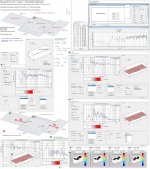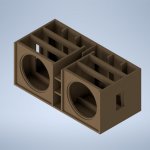I'm doing my first subwoofer build and am finally getting ready to pull the trigger. I've done a bit of modeling with different drivers in my price range, and am liking the Dayton DCS305-4 12" in WinISD. This is just about at the top end of my price range; looked at Dayton's 15" driver, but the box size was huge and excursion was blowing up.
How do these graphs look to you? Any advice for a new WinISD user?
My biggest specific question is around extrusion – I'll be giving this a 250 watt amp, but excursion only seems to do well under 125 watts. Is that normal? Should I just buy a 150 watt amp instead?
Also, are there any filters I should be applying? Planning to use the Dayton 250W plate amp.
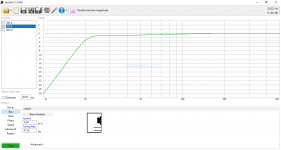
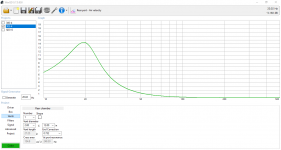
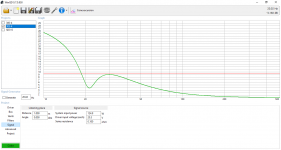
How do these graphs look to you? Any advice for a new WinISD user?
My biggest specific question is around extrusion – I'll be giving this a 250 watt amp, but excursion only seems to do well under 125 watts. Is that normal? Should I just buy a 150 watt amp instead?
Also, are there any filters I should be applying? Planning to use the Dayton 250W plate amp.



Your sim looks good.
One tip, it's generally accepted to model a driver with max excursion at + 15% over the stated xmax, so for the DCS305, stated 9.3mm + 15% = 10.69 mm for the model.
The 250 watt amp will provide lower distortion at about 50% output than a 150 watt amp at 100% output. Unless you are trying to impress your friends, you will probably never turn up the sub 100% anyways.
Hope this helps.
One tip, it's generally accepted to model a driver with max excursion at + 15% over the stated xmax, so for the DCS305, stated 9.3mm + 15% = 10.69 mm for the model.
The 250 watt amp will provide lower distortion at about 50% output than a 150 watt amp at 100% output. Unless you are trying to impress your friends, you will probably never turn up the sub 100% anyways.
Hope this helps.
Thanks for the feedback. Is 4.5 cubic feet a big box? Sorry, I see some of these boxes like the Full Marty and I think it seems tiny. Doesn't matter to me one way or the other though. I have some room to go bigger (maybe 12 cubic feet for an external size).
It's being used in a basement that's roughly 25/30' x 8/16' (it's not a perfect cube). Planning to use this almost entirely for movies and some video games.
It's being used in a basement that's roughly 25/30' x 8/16' (it's not a perfect cube). Planning to use this almost entirely for movies and some video games.
Here's my original post with some of the room info: First Sub Build - Looking for advice
How many dB of gain do you think the room would give? What frequencies should I lower? Thanks for any input you guys can offer... This is all new to me!
Room / boundary gain varies a whole bunch for a subwoofer depending in where it is placed. The most extreme cases are placed in a corner, or placed in the center of the room. The advice in all cases is to model your design paying attention to F3/F6 and xmax, then place the sub "where it sounds the best".
room placement makes a lot of difference, and only you can decide.
I'm doing my first subwoofer build and am finally getting ready to pull the trigger. I've done a bit of modeling with different drivers in my price range, and am liking the Dayton DCS305-4 12" in WinISD. This is just about at the top end of my price range; looked at Dayton's 15" driver, but the box size was huge and excursion was blowing up.
How do these graphs look to you? Any advice for a new WinISD user?
My biggest specific question is around extrusion – I'll be giving this a 250 watt amp, but excursion only seems to do well under 125 watts. Is that normal? Should I just buy a 150 watt amp instead?
Also, are there any filters I should be applying? Planning to use the Dayton 250W plate amp.
View attachment 770072 View attachment 770073 View attachment 770074
Graphs look fine, such as they are, but missing vent mach graph, so may not be what you need.
Used it a lot along with all its features that relatively few did back when it was popular, but Hornresp has become the default program nowadays around here, though I'm seeing more folks using VituixCAD lately.
Re amp selection; even though it's for HT apps, there's valuable info basic systems too, so IMNSHO everybody should be required to read and heed all of this to ensure adequate peak power [dynamic headroom] at low distortion: Gain Structure for Home Theater: Getting the Most from Pro Audio Equipment in Your System - Home Theater Forum and Systems - HomeTheaterShack.com
Re 'normal'; this depends on the speaker's alignment and what sort of performance you're trying to eek out of it. Since you went with what appears to be the default T/S max flat alignment, it's 'normal' due to requiring a net Vb > Vas, tuned < Fs, so yes, need a hi-pass filter [AKA TT 'rumble' filter] to protect it down low and maybe a low pass filter if the XO doesn't roll off the HF enough.
GM
Is 4.5 cubic feet a big box?
It's being used in a basement that's roughly 25/30' x 8/16' (it's not a perfect cube). Planning to use this almost entirely for movies and some video games.
'Big' is a design variable and since yours has a net Vb > Vas, tuned < Fs it's technically acoustically large, though 'Think' [and many here] lives in a locale where room 'real estate' is at a high premium, whereas in general, us folks in the USA are blessed with much more to the point where 4.5 ft^3 was considered a compact shelf speaker until fairly recently and even now still considered small when built as a tall column/tower/MLTL.
Even though the room will have some room gain and excellent boundary gain loading, this is a pretty anemic sub for your app.
GM
How many dB of gain do you think the room would give? What frequencies should I lower? Thanks for any input you guys can offer... This is all new to me!
Room gain begins below its first eigenmode, which is hard to accurately predict since it's doesn't have parallel walls. My SWAG is the half WL mean of 25-30 ft = ~565 ft/~27.39 ft = ~20.63 Hz, so due to presumably concrete construction except for ceiling it could rise at nearly the 6 dB/octave maximum compared to my stick built house's 3-4 dB/octave.
Unfortunately it doesn't do you much good due to the speaker's ~24 dB/octave roll-off around 20 Hz.
Boundary gain OTOH should be near the max 6 dB wall/floor and 9 dB corner/floor gain that equates to an up to 4x, 6x less power required for a given SPL or vice versa, i.e. 100 W at low over excursion could potentially get you up to nearly 120 dB/m in a corner.
In short, I wouldn't lower any frequencies, just get a decent sub DSP to maintain, shape, available dynamic headroom.
GM
Take a look att Petters Kraken. JBL car-drivers. Build your own 2x12" TH (The Kraken 212 TH)
All, thanks for the responses, and sorry for the late reply. This project is unfortunately not at the top of my list of summer projects. I am completely new to this, so I have a few follow-up questions:
- Is the vent mach graph different than the port velocity?
- I did tweak the default flat alignment a bit, but did keep it somewhat close. Tried digging into some deeper frequencies with some <3dB tradeoff.
- Net VB > Vas, tuned < Fs... Is this 'good'?
- I saw the sub described as anemic. Is this when compared with the other subs on this forum, or is it anemic modeling given these components/budget?
- It sounds like an amp with DSP is worth the extra money?
My budget is small, and I'm just looking for something that can match my little Polk RM20 speakers with 70watt/channel receiver. I literally have had no sub for the last 10 years, so right now I'm just looking for something that will round out the sound without waking up the rest of my family two floors up. Only once in a blue moon would I let the subwoofer rip.
Good to know about room placement. I've got one specific spot in mind (towards the front of the room, just to the side of the TV), but it sounds like I should have a goal of some flexibility to try out other options.
I will check out the gain structure for home theater article.
Basement is poured concrete with framed drywall for the walls.
Thank you for all the advice and any further guidance.
- Is the vent mach graph different than the port velocity?
- I did tweak the default flat alignment a bit, but did keep it somewhat close. Tried digging into some deeper frequencies with some <3dB tradeoff.
- Net VB > Vas, tuned < Fs... Is this 'good'?
- I saw the sub described as anemic. Is this when compared with the other subs on this forum, or is it anemic modeling given these components/budget?
- It sounds like an amp with DSP is worth the extra money?
My budget is small, and I'm just looking for something that can match my little Polk RM20 speakers with 70watt/channel receiver. I literally have had no sub for the last 10 years, so right now I'm just looking for something that will round out the sound without waking up the rest of my family two floors up. Only once in a blue moon would I let the subwoofer rip.
Good to know about room placement. I've got one specific spot in mind (towards the front of the room, just to the side of the TV), but it sounds like I should have a goal of some flexibility to try out other options.
I will check out the gain structure for home theater article.
Basement is poured concrete with framed drywall for the walls.
Thank you for all the advice and any further guidance.
Hi All,
FYI:Rough estimation of the FR capability in stonesif Basement Room.
b
This looks awesome. Is that a free download?
- Is the vent mach graph different than the port velocity?
- I did tweak the default flat alignment a bit, but did keep it somewhat close. Tried digging into some deeper frequencies with some <3dB tradeoff.
- Net VB > Vas, tuned < Fs... Is this 'good'?
- I saw the sub described as anemic. Is this when compared with the other subs on this forum, or is it anemic modeling given these components/budget?
- It sounds like an amp with DSP is worth the extra money?
I've got one specific spot in mind (towards the front of the room, just to the side of the TV), but it sounds like I should have a goal of some flexibility to try out other options.
You're welcome!
Same/same. You ideally want a vent mach to be < 3-5% of the SoS [~344 m/sec] depending who you ask, so at least < 344*.05 = ~17 m/s.
OK.
'Good'? Depends on whether it meets the performance needs of the app. From a strictly technical POV it's not good because it's too big, tuned too low based on the driver's published specs, thus in overall performance can't 'be all it can be'. If measured though, we may find the cab alignment more optimal or even too small and/or not tuned low enough and why we always recommend measuring the drivers to design with most accurate specs.
Yes/I'm guessing no, but don't keep up with what all is available and/or cost.
Depends on the DSP's performance capability, i.e. best to buy a separate system unless you only want some basic driver protection built into the sub, which based on your stated performance goals should be sufficient.
Hopefully, the TV is on one of the concrete walls and the sub winds up along the wall at one of the room's odd harmonics [peaks] as typical inside walls aren't stiff/massive enough to give good boundary gain. See bjorno's chart for theoretically optimal locations for places to experiment with.
GM
This has all been super helpful. Thank you all a ton. Over Labor Day, PE had a sale, so I was able to pick up the 305-4 along with an iNuke 1000 DSP for a great deal. I'm super excited about the amp.
I opted to stick with with Dayton's recommended specs for a ported sub - 3.42 cubic feet and a tuning frequency of 24 hz.
I've been doing some planning for the box and I've attached some pictures of what I've got. I think (am hoping!) this box is in good shape with enough bracing, etc. The one thing that's not reflected in the CAD images is that I'll be rounding out all the sharp internal corners of the braces and both ends of the port. I'll still take any and all suggestions if something looks off.
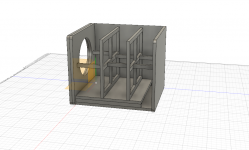
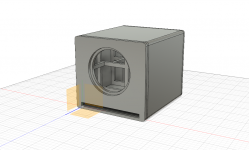
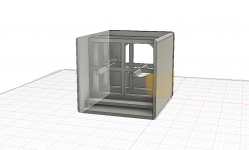
I opted to stick with with Dayton's recommended specs for a ported sub - 3.42 cubic feet and a tuning frequency of 24 hz.
I've been doing some planning for the box and I've attached some pictures of what I've got. I think (am hoping!) this box is in good shape with enough bracing, etc. The one thing that's not reflected in the CAD images is that I'll be rounding out all the sharp internal corners of the braces and both ends of the port. I'll still take any and all suggestions if something looks off.



Hi,
your construction looks complicated, but this kind of bracing will not do much good.
Build more simple, maybe half of the construction here:
You only need stripes of wood panel you cut to fit and waste no wood from cut out´s.
The bracing inside the port makes it possible to change the tune by closing a part of it, while strengthening two panels at a time. Such a construction is solid like a rock. You need not round any edge inside, the air only moves into the port, so rounding it´s in and output´s is enough. Inside the cabinet airspeed is low. This kind of bracing also helps defending resonances, as it breaks up parallel wall´s.
Use the same panel for walls and braces, make the brace 4-5 times the woods thickness, so with 3/4" fiber board make them 3 1/2" high. Place them about 6" apart. If you knock at it, the cabinet will sound "dead". So all remote energy will be used for the port and you get a "dry and fast" bass.
Construction plan by Philipp F
your construction looks complicated, but this kind of bracing will not do much good.
Build more simple, maybe half of the construction here:
You only need stripes of wood panel you cut to fit and waste no wood from cut out´s.
The bracing inside the port makes it possible to change the tune by closing a part of it, while strengthening two panels at a time. Such a construction is solid like a rock. You need not round any edge inside, the air only moves into the port, so rounding it´s in and output´s is enough. Inside the cabinet airspeed is low. This kind of bracing also helps defending resonances, as it breaks up parallel wall´s.
Use the same panel for walls and braces, make the brace 4-5 times the woods thickness, so with 3/4" fiber board make them 3 1/2" high. Place them about 6" apart. If you knock at it, the cabinet will sound "dead". So all remote energy will be used for the port and you get a "dry and fast" bass.
Construction plan by Philipp F
Attachments
Last edited:
Thanks Philipp. Cool looking design! So if I'm hearing you right, I should clear out all the internal bracing I have. Instead:
- Add 3/4" x 3-1/2" braces every 6" across the top and bottom (just above the port in my design)
- Add 3/4" vertical braces along the back
- Add 1 or 2 supports inside the port
So with modeling the ports, this would essentially turn a 1"x18" port into two 1"x8.625" ports, correct?
I am curious - How exactly would this allow you to change the tuning? It sounds like you just close off one of the ports?
- Add 3/4" x 3-1/2" braces every 6" across the top and bottom (just above the port in my design)
- Add 3/4" vertical braces along the back
- Add 1 or 2 supports inside the port
So with modeling the ports, this would essentially turn a 1"x18" port into two 1"x8.625" ports, correct?
I am curious - How exactly would this allow you to change the tuning? It sounds like you just close off one of the ports?
- Status
- This old topic is closed. If you want to reopen this topic, contact a moderator using the "Report Post" button.
- Home
- Loudspeakers
- Subwoofers
- First build - Would love some WinISD feedback
